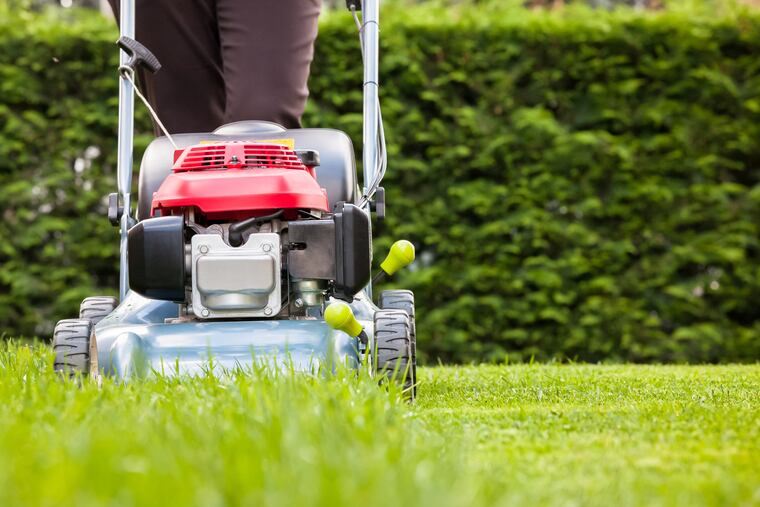It’s lawn-fixing season. Here’s how to do it.
Over time, the lawn doesn't always look so great. It needs periodic overhauling, and now is the time of year to fix it.

For some, the lawn is still about projecting the trophy landscape. For most of us, it’s the default green feature around the home. And for a third group, it’s an environmentally harmful holdover from the last century that needs to go.
Whatever your view of the lawn, it's not vanishing anytime soon. It is still America's predominant landscape element, and alternatives such as wildflower meadows are far harder to achieve than most realize.
The lawn surely should be admired for one reason alone. What other garden plant do you cut repeatedly to within an inch of its life, walk all over, and still expect to look great?
But as we know, over time, the lawn doesn't look so great. It needs periodic overhauling, and now is the time of year to fix it.
Here in the Mid-Atlantic, late August to mid-October offers the prime period for tackling thin and weedy lawns, repairs that progress from simple patching of small areas to overseeding to complete lawn renovation. You can lay sod for an instant effect, but the cost per square foot is much higher than for seed, and the laborious site preparation is still needed.
The earlier you do this, the better. Seed will germinate more quickly when soil is warm; the seedlings will be further along before fall leaf drop, when leaves must be removed; and you will have time to go back and reseed areas that didn’t take.
Weeds are not a cause of lawn failure; they are a result of it. A lawn that is kept thick and healthy will exclude weeds, though a weeding regimen is still required.
Lawns decline and fail for three main reasons: The grass is cut too short; the lawn hasn’t been fertilized properly, or the yard has poor drainage. The Mid-Atlantic has the added challenge of being too hot and humid in summer for cool-season grasses such as fescues and bluegrass and too cold in winter for some warm-season grasses.
For all these reasons, lawns degrade and need ongoing annual maintenance and, after years of neglect, a complete redo.
Geoffrey Rinehart, a lecturer in turf-grass management at the University of Maryland’s Institute of Applied Agriculture, uses a few criteria in deciding whether to renovate a lawn: Does at least 25% of the lawn consists of weeds? Is the ground “bumpy and lumpy”? and Does the existing grass consist of old, coarse-textured varieties?
Before seeding, you have to deal with the weeds. Because you have to rough up (and then smooth) the soil before seeding, you may be able to remove weeds in a small area with a metal or dethatching rake. On larger areas, this can be tackled with rented equipment, typically a rototiller.
The makeover gives you an opportunity to fix dips in the lawn and spread a layer of compost or other organic matter that will improve the soil vitality. After laying the seed, you should firm it with a roller or, in small areas, by tamping with the back of a shovel or hoe. A light blanket of straw (not hay) will help discourage bird feeding and retain moisture.
If you don’t want to tackle a full renovation, spreading seed over an existing lawn — overseeding — is a good way to thicken a declining lawn and also introduce new, better varieties of tall fescues, bred for resilience and disease tolerance.
However, spreading seed without adequate soil preparation is a waste of effort; seeds need good contact with soil to germinate and grow. In smaller lawns, this can be done by raking out the thatch and incorporating compost or other soil amendments into the soil surface.
On larger areas, rented equipment in the form of a power rake and a machine called a slit seeder will work. Some people overseed after a thorough session with a core aerator, which extracts plugs of soil that can be crumbled after drying. The aerator’s chief function is to relieve soil compaction.
Established lawns need an occasional soaking when dry to encourage deep root growth. But newly seeded lawns will require a light watering twice a day. Reduce the frequency of watering as the lawn gets established. If watering is impractical, it is better not to irrigate at all and let rainfall and dew dictate the timing of germination and growth.
The new grass should be cut when the seedlings grow a few inches. This is also a good way to keep leaf litter off the lawn. But do them a favor: Replace or sharpen the mower blade first, so the tender seedlings are cut cleanly with minimal trauma or uprooting.
Here are some popular grass varieties to consider:
Tall fescue. Valuable in regions where a temperate climate shifts to hot, humid summers. Prefer cooler summers, but breeders have worked to create new varieties that cope better with drought, various soil types and disease.
Kentucky bluegrass. Needs skillful maintenance — and chemicals — to flourish in hot, humid regions. Despite its name, it’s more often found in cooler northern states.
Perennial ryegrass. Unsuited to hotter climes, it is used as a nurse grass for other varieties, because it germinates quickly.
Fine fescue. Tolerates shadier areas better than other grasses but are prone to browning during the summer.
Zoysia grass. Expensive to install, because the standard method is with sprigs or plugs, spaced to grow together in a couple of years. An attractive turf for hot climates and can be mowed low for that groomed look. Requires less fertilizer than cool-season grasses and is thus kinder to the environment.